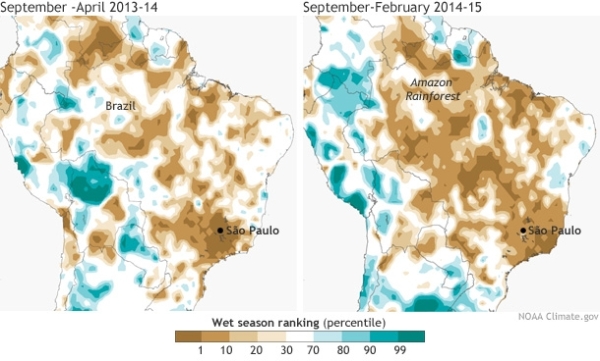For
Brazil, Climate Change Has Undone the Rains
10
March, 2015
For
the past two years, a thickening, heating, drying atmosphere over
Brazil has become the haunt of one of the worst kinds of atmospheric
bullies. A blocking high that has parched an already wounded forest
country, shrinking its reservoirs, turning rivers into ribbons, and
threatening millions with a lack of access to essential water.
The
block feeds on heat and the building inertia of a warming atmosphere
(see also Quirky
Winds Fuel Brazil Drought).
It is a new species of mutant weather animal bred by human caused
climate change. Its ilk have ranged the globe setting off terrible
droughts in places like Syria, California and Southeast Asia. But
perhaps nowhere is the undoing of rain so strange and tragic as it is
for water-rich Brazil.
Amazon
Rain Forest. The very name conjures the image of lush vegetation, of
mists, of rivers of storms riding the thick, moisture-laden airs. A
wet interplay of forest and atmosphere that has for centuries
reinforced and amplified the cycle of drawing life-giving water down
from the skies.
But
no more. Human climate change, a regional deforestation mafia, and
the ogre of a blocking high pressure system gorged on heat steroids
have put an end to that.
(The rainy season that wasn’t. NOAA map shows much depleted wet season for 2013-2014 and 2014-2015. Image source: NOAA.)
For
as of last week, reports from NOAA showed a rainy season 2/3 past and
desperately dried and behind schedule (see image above). A ‘rainy’
season in which large swaths of Brazil and the Amazon Rainforest fell
into the lowest percentile of years for moisture received.
And
the dry 2014-2015 ‘wet season’ comes just following the equally
moisture lacking 2013-2014 ‘wet season.’
Will
the Rains Briefly Return?
For
the Sao Paulo region, at the epicenter of the current blocking
pattern and deforestation induced drought, 2014 was the driest year
since record keeping began in 1930 (see Drought
in Sao Paulo).
2015, so far has only seen slightly more water. And the slight
increases in rains have only been enough to push Sao Paulo’s
largest aquifer — the Cantariera — to 12.9 percent capacity, even
when dead pool volumes are included (without the new dead pool
volume, Cantariera would be sitting around 9 percent).
With
a little more than a month and a half remaining to a notably stunted
rainy season, the Cantariera will be fortunate to hit 1/5 capacity by
late April. A situation which could see the most populated region in
Brazil desperately shy of water and continuing current rationing at
least for the next year.
However,
a newly emerging Pacific El Nino may draw back on current moisture
flows to the region, putting a lid on late season rainfalls and
pumping up the blocking high yet again (see ENSO
and Drought Forecasting).
If the forecast rains do not arrive and the block again tightens its
grip over the region, Sao Paulo could be looking at running out of
water for many of citizens over a 4-6 month period.
Megadrought
For The Deforest
Regardless
of whether a brief spate of rainfall provides new hope for avoiding a
complete collapse of Sao Paulo’s water supplies for 2015, the long
term situation looks increasingly dire. Added heat from human-caused
warming combines with rampant deforestation in Brazil to create a
kind of drought death spiral. Already baking under the heat of an
equatorial sun, the clear-cut and burned Amazon is now struggling to
retain moisture. Understory fires and gradually building heat due to
human warming at the rate of 0.25 C per decade for the rainforest
provide additional stress to a critical forest region.
(2013 JPL study found that climate change was weakening the Amazon’s ability to recover from severe droughts like the one seen in this 2005 moisture anomaly capture. Under human caused climate change, droughts become far more frequent and intense. A 2009 study found that 85% percent of the Amazon would likely be lost due to climate change alone at 4 C of warming. Even mild warming of slightly more than 1 C could result in additional losses of 20-40 percent.)
A
recent report in The
Economist estimates
that 30,000 new trees would need to be planted to help rejuvenate the
‘flying rivers’ that continuously feed moisture to the
rainforest. Deforestation, as well, would necessarily have to stop.
And even if these two requirements were met, human caused warming
would have to be quite mild to spare
the Amazon conflagration and conversion to much drier savannah and
grasslands.
Given
these dire challenges, it must be assumed that Brazil, much like the
US Southwest and other regions of the world faces the prospect of
potential megadrought over the coming years and decades. So what we
are seeing for Sao Paulo now is, sadly, prelude.
Links:
Hat
Tips:
Andy
Colorado
Bob
Kevin
Jones
Eleggua





No comments:
Post a Comment
Note: only a member of this blog may post a comment.